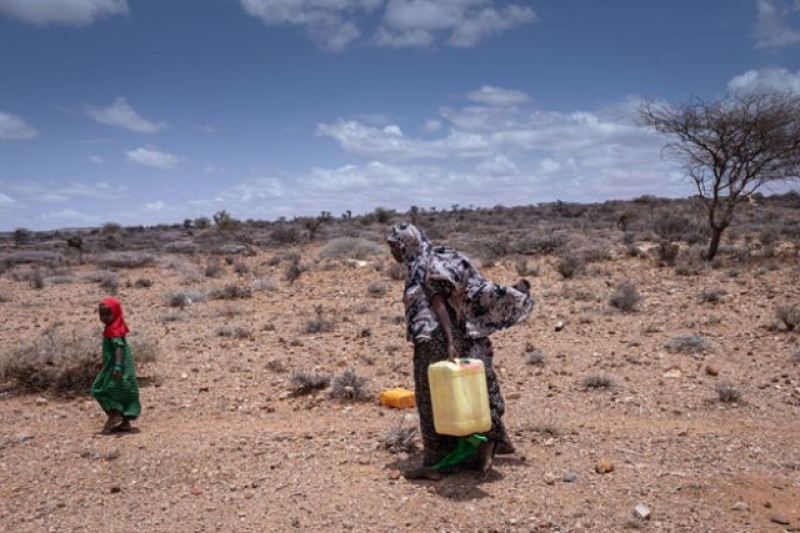- Trump considering military options on Greenland; Europe rejects |
- Fertiliser crunch threatens Kushtia’s onion boom despite high prices |
- Security Council Divided on United States' Venezuela Action |
- Over 1.53m voters register for postal balloting: Shafiqul Alam |
- Bangladesh Bank to liquidate 9 NBFIs in financial sector reforms |
Climate Groups Report, 2025 Unlikely To Be Hotter Than 2024

A woman in the Horn of Africa carrying water back to her home. Credit- UNICEF-Mulugeta Ayene
By Oritro Karim
UNITED NATIONS, Apr 23 2025 (IPS) - On March 19, the World Meteorological Organization (WMO) and the Copernicus Climate Change Service (C3S) issued a report on the State of Global Climate in 2024, detailing the numerous heightened natural disasters that were a consequence of human-induced climate change. With the past three years having been recorded as the three hottest years in human history, climate scientists are optimistic that 2025 will see slightly cooler global temperatures.
Despite this, Europe is projected to experience its hottest year ever recorded. On April 15, the World Meteorological Organization (WMO) and the Copernicus Climate Change Service (C3S) issued the second annual report on the European State of the Climate, finding that the average temperature in March 2025 was approximately 1.6C (2.88F) higher than in pre-industrial times, and 0.26C (0.468F) higher than the previously highest recorded March in 2014.
“Europe is the fastest-warming continent and is experiencing serious impacts from extreme weather and climate change. Every additional fraction of a degree of temperature rise matters because it accentuates the risks to our lives, to economies and to the planet,” said WMO Secretary-General Celeste Saulo.
Additionally, according to figures from the National Oceanic and Atmospheric Administration (NOAA), this January was recorded as the hottest January in human history. NOAA’s National Centers for Environmental Information (NCEI) also states that there is roughly a 7 percent chance that the entirety of 2025 will surpass the average global temperatures recorded in 2024. Additionally, arctic sea ice has reached its lowest extent in January, recording at 6 percent below average.
This can be attributed to the La Niña phenomenon, which is also known as the cooling phase of the El Niño-Southern Oscillation (ENSO) cycle. Beginning in December 2024 and ending in April 2025, La Niña is defined by the cooling of ocean surface temperatures, changes in wind and precipitation patterns, an increase in Atlantic hurricanes, drier conditions in the South, and wetter conditions in the Northwest.
Tropical regions, which have historically been impacted the hardest by El Niño, have experienced varying degrees of relief from high temperatures and climate disasters due to the cooling effects of La Niña. With La Niña bringing rainfall to areas that have experienced drought in the past year, local economies dependent on agriculture will likely experience less hardship in producing yields. Areas such as South America, which have experienced flooding last year are projected to have faced drier conditions in the past few months.
Additionally, NOAA states that La Niña has had a profound impact on marine life off the Pacific coast. This phenomenon pushes cold, nutrient-rich waters to the surface of the coast, creating a hospitable environment for fish and phytoplankton. Cold-water species, like squid and salmon, are also attracted to these areas, nourishing the fishing industries in these areas.
A report from the Food and Agriculture Organization (FAO) indicates that La Niña will adversely impact certain areas. For example, the Horn of Africa is estimated to be one of the hardest-hit areas. Somalia, southern Ethiopia, and northern Kenya are expected to see crop and livestock losses as a result of droughts caused by La Niña, exacerbating acute food insecurity and disrupting regional financial stability.
According to figures from WMO, the effects of La Niña are expected to fade by the midpoint of the year. The agency states that there is roughly a 60 percent chance that conditions will shift back to ENSO-neutral temperatures by March-May 2025, with the probability of this increasing by ten percent for April-June 2025. ENSO-neutral temperatures indicate that temperatures are not increased or decreased, respectively, by El Niño or La Niña. WMO Secretary-General Celeste Saulo states that conditions as a result of El Niño are not expected to return at this time.
However, it is imperative that governments and climate scientists use trends in weather patterns to prepare for natural disasters. “Seasonal forecasts for El Niño and La Niña and the associated impacts on weather and climate patterns globally are an important tool to inform early warnings and early action…These forecasts translate into millions of dollars’ worth in economic savings for key sectors like agriculture, energy and transport, and have saved thousands of lives over the years by enabling disaster risk preparedness,” added Saulo.
According to climate scientist Gavin Schmidt, with ENSO-neutral conditions having returned, 2025 is expected to be the third-hottest year on record, falling behind 2024 and 2023, but ahead of 2016. Despite minor improvements from the previous year, recent developments, such as the United State’s withdrawal from the Paris Agreement and the reduction of climate programs funded by USAID, threaten to push the United Nations (UN) Sustainable Development Goals (SDGs) out of reach.
“As one of the world’s largest carbon emitters, the United States has a responsibility to lead the way in ditching fossil fuels and supporting the worldwide transition to zero carbon economies,” said Paul O’Brien, the Executive-Director of Amnesty International USA. “By refusing to join the international community in taking the necessary steps to drastically reduce greenhouse gas emissions, President Trump is skirting that responsibility. Worst yet, such a move will only encourage other leaders to follow suit.”
IPS UN Bureau Report

